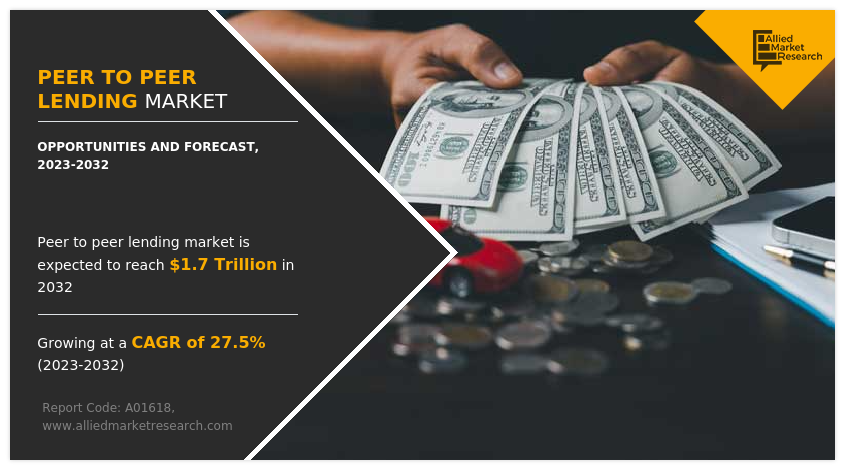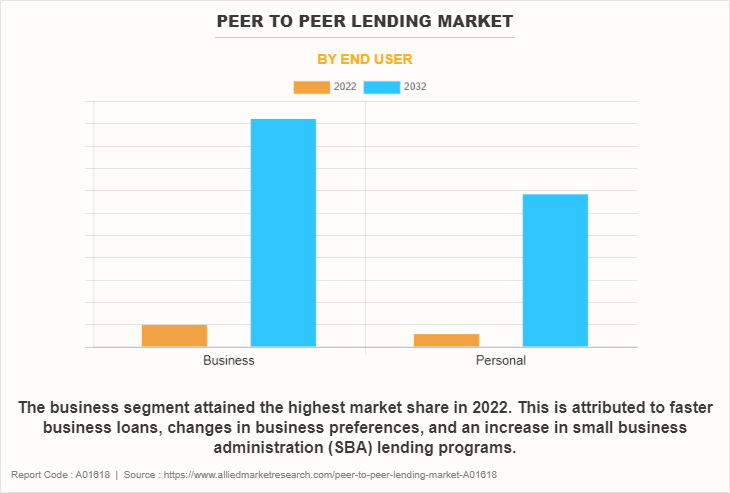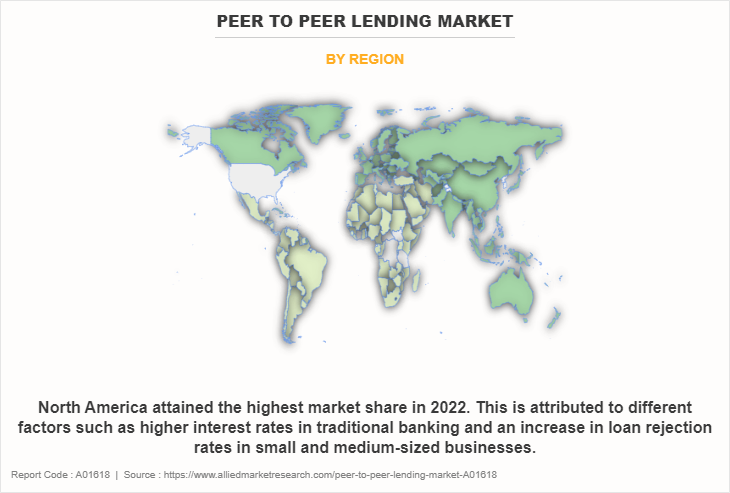Peer To Peer Lending Market Overview
The global peer to peer lending market was valued at $153 billion in 2022, and is projected to reach $1.7 trillion by 2032, growing at a CAGR of 27.5% from 2023 to 2032. Growing demand for alternative lending, easier access to credit, lower interest rates, digital platforms' convenience, and increasing investor interest in diversified assets contribute to the growth of the market.
Market Dynamics & Insights
- The peer to peer lending industry in North America held the largest share of 62% in 2022.
- The peer to peer lending industry in India is expected to grow significantly at a CAGR of 35.2% from 2023 to 2032.
- By business model, the traditional lending segment is one of the dominating segment in the market, accounting for the revenue share of 76% in 2022.
- By loan type, the small business loans segment dominated the industry in 2022 and accounted for the largest revenue share of 41%.
Market Size & Future Outlook
- 2022 Market Size: $152.92 Billion
- 2032 Projected Market Size: $1701.2 Billion
- CAGR (2023-2032): 27.5%
- North America: Dominated the market in 2022
- Asia Pacific: Fastest growing market
What is Meant by Peer to peer lending
Peer to peer lending is a form of direct lending of money to individuals or businesses without an official financial institution participating as an intermediary in the deal. P2P lending is generally done through online platforms that match lenders with potential borrowers. It offers both secured and unsecured loans. However, most of the loans in P2P lending are unsecured personal loans. Secured loans are rare for the peer to peer lending industry and are usually backed by luxury goods. Due to some unique characteristics, peer to peer lending is considered as an alternative source of financing.

The lesser operating cost and low market risk associated with P2P lending is one of the primary drivers of the peer to peer lending market. P2P lending platform helps in reducing operational costs by decreasing the cost of physical branches, staffing, and maintenance of branches, thus augmenting the growth of the market. Furthermore, an increase in technological advancements in P2P lending platforms accelerates the peer to peer lending market growth. However, one significant factor hindering the growth of the peer to peer lending market is regulatory challenges. Many countries have struggled to create clear rules and protections for both borrowers and lenders in the P2P lending space, making it riskier and less attractive for potential participants.
Moreover, risks associated with P2P lending such as the higher risk of default limit the growth of the peer to peer lending market. Since P2P lending involves lending money to individuals or small businesses, there is a higher risk of default in peer-to-peer compared to traditional banks in peer to peer lending Industry.
Economic downturns or unexpected financial troubles can lead to higher default rates, making lenders wary of investing in P2P loans. On the contrary, increase in demand for alternative lending options is expected to provide lucrative growth opportunities to the peer to peer lending market in the upcoming years. Furthermore, technological innovations make P2P lending more attractive to both borrowers and lenders, opening avenues for growth in the peer to peer lending market.
The report focuses on growth prospects, restraints, and trends of the peer to peer lending market forecast. The study provides Porter’s five forces analysis to understand the impact of various factors such as bargaining power of suppliers, competitive intensity of competitors, threat of new entrants, threat of substitutes, and bargaining power of buyers on the peer to peer lending market outlook.
Peer-To-Peer Lending Market Segment Review
The peer to peer lending market is segmented into business model, loan type, end user, and region. By business model, the market is differentiated into traditional lending, and alternate marketplace lending. On the basis of loan type, it is segmented into consumer credit loans, small business loans, student loans, and real estate loans. Depending on end user, it is fragmented into business and personal. Region-wise, the market is segmented into North America, Europe, Asia-Pacific, and LAMEA.

By end user, the business segment dominated peer to peer lending market in 2022. This is attributed to faster business loans, changes in business preferences, and an increase in small business administration (SBA) lending programs. However, the personal segment is expected to be the fastest-growing segment during the forecast period. This is attributed to the change in consumer expectations and simplified lending processes via mobile applications and other financial management tools.

Region-wise, North America dominated the peer to peer lending market share in 2022. This is attributed to different factors such as higher interest rates in traditional banking and an increase in loan rejection rates in small and medium-sized businesses. However, Asia-Pacific is considered to be the fastest-growing region during the forecast period. This is attributed to factors such as development in financial institutions, minimal lending regulations, and rise in number of crowd lending platform in the emerging countries such as India and Japan.
The key players operating in the peer to peer lending market include Funding Circle Limited, LendingClub Bank, SocietyOne, Harmoney Australia Pty Ltd, Linked Finance, Lending Loop, LendingTree, LLC, Prosper Funding LLC, Upstart Network, Inc., and goPeer. These players have adopted various strategies to increase their market penetration and strengthen their position in the peer to peer lending industry.
Market Landscape and Trends
The peer to peer lending sector is at a turning point in its evolution. P2P platforms enter the mainstream, offering government-backed loans, inflation-beating returns, and unprecedented support for small and medium-sized enterprises (SMEs). Furthermore, key players in the peer to peer lending market adopt various strategies such as partnerships and product launches to expand their product portfolio. For instance, in December 2021, Upstart, a leading artificial intelligence (AI) lending platform, and the National Bankers Association (NBA) formed a partnership to improve access to affordable credit for customers of minority-owned depository institutions (MDIs) through a unique agreement to use Upstart’s AI lending platform.
The partnership with Upstart offers MDIs advanced digital lending technology and the ability to provide smaller personal loans economically to their communities. Smaller loan amounts can help borrowers recover from short-term setbacks, without paying exorbitant interest rates from payday lenders that can quickly turn into cycles of debt. Therefore, this strategy provides growth opportunities to the peer to peer lending market.
The COVID-19 pandemic had a moderate impact on the peer to peer lending market size, owing to the fact that many borrowers faced financial uncertainty, leading to a decrease in loan demand. People were worried about their jobs and income, so they were less likely to borrow money through P2P lending platforms. Moreover, the peer-to-peer lending market focus on providing an alternative to traditional banking by connecting borrowers directly with investors, offering competitive interest rates and flexible lending options. However, lenders became more cautious, fearing that borrowers might not be able to repay their loans due to economic instability. This cautious approach led to a decrease in the supply of loans from P2P lenders. However, as the pandemic continued, some peer to peer lending investing platforms adapted to the new reality by implementing stricter risk assessment criteria and offering COVID-19-related relief measures to borrowers. This helped stabilize the market to some extent. In addition, the low-interest-rate environment created by central banks in response to the economic downturn made P2P lending more attractive to investors seeking higher returns. As a result, the overall size of the peer to peer lending market was moderately impacted during the pandemic.
What are the Top Impacting Factors in Peer to Peer Lending Market
Lesser Operating Cost and Low Market Risk
P2P lending solution neither requires infrastructure/buildings nor large workforce unlike traditional banks. P2P lending platform functions via internet-based services. The data is available to the public, and the online services allow access to their sites, giving a clearer picture to consumers about loans and their types available. These lending platforms make money by charging fees to borrowers and deducting fees from the loan repayments made to investors, which propels the growth of the peer to peer lending market.
Furthermore, P2P lending platform helps in reducing the operational costs by decreasing the cost of physical branches, staffing, and maintenance of branches, thus augmenting the growth of the market. Moreover, peer to peer lending platform provides a suitable plan to ensure borrower’s repayment process, which reduces the market risk of the investor. With the help of peer to peer financing, investors can reduce different types of market risks such as interest rate, unemployment rates, and property prices risk, which further positively impacts the growth of the global peer to peer lending market.
Increase in Technological Advancements
Digitization has been one of the most widely adopted strategies in financial services to improve core processing capabilities and offer enhanced consumer services and insights. peer-to-peer lending adoption has an innovative edge over traditional banking systems, owing to the fact that it offers higher transparency in businesses. Furthermore, P2P lending platforms often use advanced algorithms and data analysis to match borrowers with the right lenders. This technology helps in assessing the risk of lending to someone and helps lenders spread their money across many loans, reducing the risk of losing everything if one borrower has trouble. These smart tech tools give both borrowers and lenders more confidence in using P2P lending platforms, making them even more popular in peer-to-peer lending sector.
In addition, key players in the market adopt key strategies such as partnership and product launch to improve their product portfolios. For instance, in February 2022, Funding Circle partnered with Chaser so customers of the credit control app can apply for a loan from the peer to peer lending platform directly from their account. Chaser contacts its eligible customers to let them know they can apply for a business loan or state-backed recovery loan scheme finance from the P2P platform.
Increase in Demand for Alternative Lending Options and Technological Innovations
The demand for alternative lending options is rising. Many people and small businesses are looking for loans outside of traditional banks, and P2P lending platforms offer a convenient and faster way to access funds. This increase in demand for alternative lending options creates a lucrative opportunity for P2P lending platforms to expand their user base and loan offerings. In addition, advancements in technology and data analysis are bolstering the peer-to-peer lending market platforms. These platforms can use sophisticated algorithms to assess borrowers' creditworthiness, reducing the risk of default. Furthermore, blockchain technology is being explored to enhance transparency and security in peer-to-peer lending transactions. These technological innovations make P2P lending more attractive to both borrowers and lenders, opening avenues for growth in the peer to peer lending market.
Report Coverage & Deliverables
Type Insights
The consumer lending segment dominated the market in 2022 with a revenue share of more than 59.0%. One of the significant benefits of P2P lending is the ability for borrowers to secure loans at lower interest rates compared to traditional banks or credit unions. This advantage stems from the fact that P2P lenders operate with lower overhead costs, enabling them to offer loans at more competitive rates. Moreover, P2P lending platforms typically have a more efficient underwriting process, contributing to lower lending costs and making P2P lending an attractive option for consumers seeking affordable borrowing opportunities in peer to peer lending market.
Solution Type Insights
The repaying bank debt segment dominated the market in 2022 with a global revenue share of over 33.0%. Many borrowers use P2P lending to consolidate and refinance their bank debt. By taking out a P2P loan, borrowers can potentially secure more favorable terms, such as lower interest rates or longer repayment periods, compared to their existing bank loans. This enables them to manage their debt better and reduce their overall financial burden in peer to peer lending market.
Regional Insights
North America dominated the peer-to-peer lending market in 2022 with a revenue share of more than 30.0%. The North America region has a highly developed financial ecosystem with a strong emphasis on innovation and technological advancements. This environment has nurtured the growth of P2P lending platforms and attracted both borrowers and investors. In addition, North America has a large population of tech-savvy individuals who are comfortable with online transactions and digital platforms, making them more receptive to P2P lending. Furthermore, the regulatory framework in North America has been relatively supportive of P2P lending, providing a conducive environment for platform growth in peer to peer lending market.
Key Companies & Market Share Insights
The key players in the peer-to-peer lending market focus on factors such as loan interest rates, borrower experience, investor returns, and risk management. They leverage technology to streamline the lending process, utilizing algorithms and data analytics to assess creditworthiness and mitigate risk. In addition, partnerships and collaborations with financial institutions and other market players help enhance their market position. As the market evolves, new entrants and innovative platforms are emerging, introducing novel lending models and technologies. This intensifies competition and encourages established players to innovate and improve their offerings continually in peer-to-peer lending companies.
In June 2023, PeerBerry investors provided financing of USD 71.08 million for loans and received USD 8,94,252.9 in interest. The total amount of loans funded on the PeerBerry platform increased by 3% compared to the previous month. As of the end of June, PeerBerry's portfolio has reached a value of USD 125.7 million.
What are the Key Benefits for Stakeholders
- This report provides a quantitative analysis of the market segments, current trends, estimations, and dynamics of the peer to peer lending market analysis from 2022 to 2032 to identify the prevailing peer to peer lending market opportunity.
- Market research is offered along with information related to key drivers, restraints, and opportunities.
- The Porter's five forces analysis highlights the potency of buyers and suppliers to enable stakeholders to make profit-oriented business decisions and strengthen their supplier-buyer network.
- In-depth analysis of the peer to peer lending market segmentation assists to determine the prevailing peer to peer lending market opportunities.
- Major countries in each region are mapped according to their revenue contribution to the peer to peer lending market.
- Market player positioning facilitates benchmarking and provides a clear understanding of the present position of the peer to peer lending market players.
- The report includes the analysis of the regional as well as peer to peer lending market trends, key players, market segments, application areas, and market growth strategies.
Peer to Peer Lending Market Report Highlights
| Aspects | Details |
| Market Size By 2032 | USD 1.7 trillion |
| Growth Rate | CAGR of 27.5% |
| Forecast period | 2022 - 2032 |
| Report Pages | 125 |
| By Business Model |
|
| By Loan Type |
|
| By End User |
|
| By Region |
|
| Key Market Players | Harmoney Australia Pty Ltd, LENDINGCLUB BANK, SocietyOne, Linked Finance, Lending Loop, Prosper Funding LLC, goPeer, LendingTree, LLC, Funding Circle Limited, Upstart Network, Inc. |
Analyst Review
Advancements in technology and data analysis are bolstering the peer to peer (P2P) lending market. These platforms can use sophisticated algorithms to assess borrowers' creditworthiness, reducing the risk of default. Moreover, blockchain technology is being explored to enhance transparency and security in P2P lending transactions. These technological innovations make P2P lending more attractive to both borrowers and lenders, opening avenues for growth in the industry.
Furthermore, some P2P platform owners and stakeholders forecast increased adoption of technologies such as open banking and blockchain. For instance, Kuflink, a peer to peer investment platform is working on implementing open banking for real-time borrower verification, payments and to improve processes, while Lendwise, an FCA-regulated online peer to peer finance lender specializing in education finance is looking to use it to help assess creditworthiness.
The COVID-19 pandemic had a negative impact on the peer to peer lending market, owing to the fact that many borrowers faced financial uncertainty, leading to a decrease in loan demand. People were worried about their jobs and income, so they were less likely to borrow money through P2P lending platforms. However, lenders became more cautious, fearing that borrowers might not be able to repay their loans due to economic instability. This cautious approach led to a decrease in the supply of loans from P2P lenders. As a result, the overall size of the P2P lending market decreased during the pandemic.
The key players in the peer to peer lending market include Funding Circle Limited, LendingClub Bank, SocietyOne, Harmoney Australia Pty Ltd, Linked Finance, Lending Loop, LendingTree, LLC, Prosper Funding LLC, Upstart Network, Inc., and goPeer. Major players operating in this market have witnessed significant adoption of strategies that include business expansion and partnership to reduce supply and demand gap. With an increase in awareness & demand for peer to peer lending across the globe, major players are collaborating their product portfolio to provide differentiated and innovative products.
The global peer-to-peer lending market was valued at $153 billion in 2022 and is projected to reach $1.7 trillion by 2032, growing at a CAGR of 27.5% from 2023 to 2032.
Peer-to-peer lending involves direct lending of money to individuals or businesses without an official financial institution as an intermediary, typically facilitated through online platforms.
Key players in the peer-to-peer lending market include Avant LLC, Braviant Holdings, Fundbox, and Funding Circle.
Region-wise, North America dominated the peer to peer lending market share in 2022.
Factors driving the market include lower operating costs, reduced market risk, and technological advancements in P2P lending platforms.
Challenges include regulatory issues and a higher risk of default compared to traditional banking.
Loading Table Of Content...
Loading Research Methodology...



